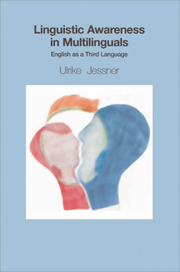Book contents
- Frontmatter
- Contents
- List of figures and tables
- List of abbreviations
- Acknowledgements
- Introductory remarks
- 1 Multilingualism with English
- 2 Learning and using a third language
- 3 On the nature of linguistic awareness
- 4 Exploring linguistic awareness in third language use
- 5 Crystallizing linguistic awareness in multilingual education
- 6 Envoi
- References
- Index
3 - On the nature of linguistic awareness
Published online by Cambridge University Press: 05 September 2013
- Frontmatter
- Contents
- List of figures and tables
- List of abbreviations
- Acknowledgements
- Introductory remarks
- 1 Multilingualism with English
- 2 Learning and using a third language
- 3 On the nature of linguistic awareness
- 4 Exploring linguistic awareness in third language use
- 5 Crystallizing linguistic awareness in multilingual education
- 6 Envoi
- References
- Index
Summary
Ever since the seminal work of Peal and Lambert (1962), who found that bilingual children showed cognitive advantages over their monolingual counterparts and attributed this result to the metalinguistic abilities of their informants, interest in metalinguistic tasks, metalinguistic awareness and metalinguistic skills in connection with bi- and multilingualism has increased over the years. The latest studies by Bialystok and her collaborators, which have raised public interest world-wide, showed that the cognitive advantages of bilingualism also persist in elderly adults (Bialystok et al. 2004).
A look at the history of research so far makes clear though that to date interest in metalinguistic awareness has mainly been reflected in studies on FLA where the onset of metalinguistic awareness in the language development of monolingual children has been the focus of attention. In bilingualism and SLA studies metalinguistic awareness has been the focus to a lesser extent. In recent years, however, an increase in interest in the topic has been stimulated by the pedagogically motivated ‘language awareness’ movement (see, for example, Hawkins 1984; James and Garrett 1991; Van Lier 1995).
The following discussion is intended to provide a state-of-the-art description of research on metalinguistic awareness including the presentation of the functions and roles that metalinguistic awareness in multilingual speech and learning can fulfil. This chapter starts with a look at the sometimes confusing variety of related terms used in the study of metalinguistic awareness and language awareness.
- Type
- Chapter
- Information
- Linguistic Awareness in MultilingualsEnglish as a Third Language, pp. 36 - 71Publisher: Edinburgh University PressPrint publication year: 2006



